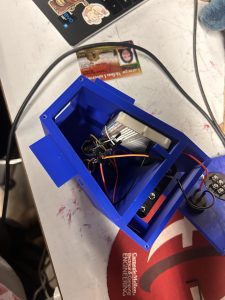Overall Status Update – 3/22
This past week, progress continued on both the hardware and firmware for Bearbot. The hardware components, including buttons, the rotary encoder, lights, humidifier module, and touch sensor, have been soldered for easy connection to the Raspberry Pi and tested successfully. Debugging is ongoing for the audio chip, which is not currently outputting sound, with a potential replacement if needed. The interior shell remains plastic for now, with contingency plans to use clear 3D-printed plastic if resin printing is unavailable before interims. The exterior is progressing, with all face casts completed and work continuing on the body design in Fusion 360.
On the firmware side, the focus has been on setting up the Raspberry Pi and preparing for OLED and input testing. Some challenges with SSH connectivity have slowed initial testing, but the interaction logic for buttons, rotary encoder, and mode-switching has been outlined. Next steps include resolving the connection issues and beginning full firmware testing once hardware is finalized.
Kayla’s Status Report for 3/22
Taylor’s Status Report for 3/22
Hardware
Progress is still being made on the hardware front.
All the buttons, the rotary encoder, lights, humidifier module, and touch sensor have been soldered to wires for easy hookup to the Raspberry Pi and confirmed to work.
I am working on debugging the audio chip, since it does not seem to be outputting anything when connected to the speakers. I might have to switch out the chip for a different one if it is defective.
We are on track for the hardware to be complete and passed off to Kayla this week.

Interior
The interior shell of the Bearbot is still made of plastic; if the resin printers are not operational, we might have to fall back and 3D print out of clear plastic and replace it with a resin print after interims.
Exterior
All of the casts for the face of the bearbot have been 3D printed, and I am currently working on the Fusion 360 for the casts of the body.

